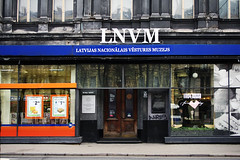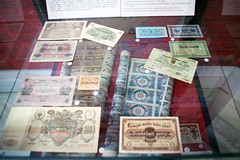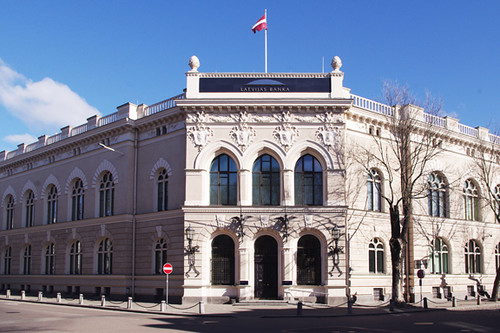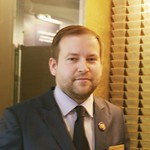
Numismatourist Howard Berlin forwarded this report on his recent trip to visit numismatic museums in Riga, Latvia. Thanks! -Editor
 After an overnight stay in Berlin, I headed for Latvia’s capital city, Riga, on the third of
nine flights I would take on this 12-day European trip. Here, there are two numismatic exhibitions. The first one I went to see was the
“semi-permanent” exhibit of the National History Museum of Latvia. I use the term “semi-permanent” as the numismatic part of the museum’s
exhibition is still a work in progress. It is housed in a temporary location in a neo-Renaissance style building that was built in 1875, as
the Riga Castle, which originally housed the National History Museum (plus several other state museums and the residence of Latvia’s
president ), was severely damaged by a 2013 fire. It may not be until 2018 when the permanent exhibition will be relocated back at the
castle. After an overnight stay in Berlin, I headed for Latvia’s capital city, Riga, on the third of
nine flights I would take on this 12-day European trip. Here, there are two numismatic exhibitions. The first one I went to see was the
“semi-permanent” exhibit of the National History Museum of Latvia. I use the term “semi-permanent” as the numismatic part of the museum’s
exhibition is still a work in progress. It is housed in a temporary location in a neo-Renaissance style building that was built in 1875, as
the Riga Castle, which originally housed the National History Museum (plus several other state museums and the residence of Latvia’s
president ), was severely damaged by a 2013 fire. It may not be until 2018 when the permanent exhibition will be relocated back at the
castle.
 I was met by the museum’s chief curator, Dr. Anda Ozolina who briefly gave me an
overview of the museum and then left me to explore on my own. Only bits and pieces of the collection that was in the castle are currently
on display, which are integrated among other historical artifacts. Most items were banknotes from the 1918-1940 period of the Latvian
Republic and did not include Medieval and Livonian specimens, or 17th century coin hoards. Unfortunately for me, much of the text material
was only in Latvian so it was difficult to ascertain the significance of the many displays. I was met by the museum’s chief curator, Dr. Anda Ozolina who briefly gave me an
overview of the museum and then left me to explore on my own. Only bits and pieces of the collection that was in the castle are currently
on display, which are integrated among other historical artifacts. Most items were banknotes from the 1918-1940 period of the Latvian
Republic and did not include Medieval and Livonian specimens, or 17th century coin hoards. Unfortunately for me, much of the text material
was only in Latvian so it was difficult to ascertain the significance of the many displays.
 After leaving the museum and walking back to my hotel, I passed a
7-11 type convenience store which also sells wine and liquor. I was looking for a bottle of slivovitz (aka slivovice) – which is a plum
brandy, typically 85 to 100 proof, that is popular in the Czech Republic and a few other East European countries which my family drinks it
every Friday night after dinner. The store didn’t have any but at one end of the building I saw a shop that sold coins, banknotes, gold
bullion, and numismatic supplies. Besides the large selection of pre-euro Latvian and other foreign coins and notes, I noticed a small
selection of U.S. coins and a $10 bill on the cashier’s window which also doubled as a foreign exchange spot. After leaving the museum and walking back to my hotel, I passed a
7-11 type convenience store which also sells wine and liquor. I was looking for a bottle of slivovitz (aka slivovice) – which is a plum
brandy, typically 85 to 100 proof, that is popular in the Czech Republic and a few other East European countries which my family drinks it
every Friday night after dinner. The store didn’t have any but at one end of the building I saw a shop that sold coins, banknotes, gold
bullion, and numismatic supplies. Besides the large selection of pre-euro Latvian and other foreign coins and notes, I noticed a small
selection of U.S. coins and a $10 bill on the cashier’s window which also doubled as a foreign exchange spot.

National Bank of Latvia
The other notable exhibition in Riga was the Naudas Pasaules (Money World) exhibition at the Bank of Latvia’s Visitor Center, which is
across the square from the Riga Castle. Generally, admission is only done by web-registration, and the next available opening for tours
would be several days after I would leave Riga. Luckily, an e-mail followed by a phone call to the bank circumvented this process and I had
an appointment to see the exhibition the day before I was to depart Riga. Similar to some of the Federal Reserve Banks and many other
central banks that have exhibits, a photo ID or passport was required for admission to receive a visitor’s badge.
 The bank’s exhibition has been around for about 10 years and will close down in a few months so that the area can be expanded and will
probably reopen about a year later in 2016. In the lobby I was met by Kaspars Kravinskis, the exhibit’s manager, who graciously took time
out of his busy schedule to give me a one on one tour of the exhibition.
The bank’s exhibition has been around for about 10 years and will close down in a few months so that the area can be expanded and will
probably reopen about a year later in 2016. In the lobby I was met by Kaspars Kravinskis, the exhibit’s manager, who graciously took time
out of his busy schedule to give me a one on one tour of the exhibition.

National Bank of Latvia exhibit
The exhibition area was quite impressive with its displays, interactive computer screens that provided identical information in Latvian,
Russian, and English.
Next week: Bucharest.
Wayne Homren, Editor
The Numismatic Bibliomania Society is a non-profit organization
promoting numismatic literature. See our web site at coinbooks.org.
To submit items for publication in The E-Sylum, write to the Editor
at this address: whomren@gmail.com
To subscribe go to: https://my.binhost.com/lists/listinfo/esylum
Copyright © 1998 - 2020 The Numismatic Bibliomania Society (NBS)
All Rights Reserved.
NBS Home Page
Contact the NBS webmaster
|







